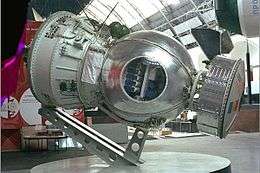Kosmos 782
|
On display at the Moscow Space Museum: The circular viewport was installed for display purposes. | |
| Mission type | Bioscience |
|---|---|
| Operator | Institute of Biomedical Problems / NASA |
| COSPAR ID | 1975-110A |
| SATCAT № | 08450 |
| Mission duration | 19.5 days |
| Spacecraft properties | |
| Spacecraft type | Bion |
| Manufacturer | TsSKB |
| Launch mass | 6,000 kilograms (13,000 lb) |
| Start of mission | |
| Launch date | 25 November 1975, 14:00:00 UTC |
| Rocket | Soyuz-U |
| Launch site | Plesetsk 43/3 |
| End of mission | |
| Landing date | 15 December 1975, 04:48 UTC[1] |
| Landing site |
52°17′N 64°11′E / 52.283°N 64.183°E Near Amankaragaj, Kazakh SSR, USSR |
| Orbital parameters | |
| Reference system | Geocentric |
| Regime | LEO |
| Eccentricity | 0.0112575[2] |
| Perigee | 218 kilometres (135 mi) |
| Apogee | 368 kilometres (229 mi) |
| Inclination | 62.8059º |
| Period | 90.5 minutes |
| RAAN | 194.5624 degrees |
| Argument of perigee | 106.9635 degrees |
| Mean anomaly | 254.3835 degrees |
| Mean motion | 15.93175436 |
| Epoch | 14 December 1975, 22:02:00 UTC |
| Revolution number | 305 |
Bion 3 or Kosmos 782 (in Russian: Бион 3, Космос782) was a Bion satellite. It was the first joint U.S.–Soviet biomedical research flight. It carried 14 experiments prepared by seven countries in all, with participation from scientists in France, Czechoslovakia, Hungary, Poland, and Romania.
Mission
Launched from Plesetsk Cosmodrome on November 25, 1975, the biosatellite was recovered in Siberia on December 15 after 19.5 days. It included a centrifuge with revolving and fixed sections in which identical groups of animals, plants, and cells could be compared. The subject animals included white rats and tortoises. The effects of aging on fruit fly livers and plant tissues with grafted cancerous growths were also studied.
More than 20 different species were flown on the mission, including 25 unrestrained male Wistar rats, fruit flies (Drosophila melanogaster), carrot tissues, and 1,000 embryos of the fish Fundulus heteroclitus (a small shallow-water minnow). A U.S. radiation dosimeter experiment was also carried out without using biological materials. This was the only Bion mission where the United States provided some of the biological specimens.[3]
Details
- NSSDC ID
- 1975-110A [4]
- Launch date/time
- 1975-11-25 at 14:00:00 UTC
- On-orbit dry mass
- 4000 kg
- Other names
- Biocosmos 3
- Cosmos 782
- 08450
See also
References
- ↑ Bion. Zarya. Retrieved 2016-06-10.
- ↑ Chris Peat. COSMOS 782. Heavens Above. Retrieved 2016-06-18.
- ↑ "4.G The Cosmos Biosatellite Program". Lis.arc.nasa.gov. Retrieved 2014-03-12.
- ↑ "NASA - NSSDC - Spacecraft - Details". Nssdc.gsfc.nasa.gov. 2013-08-16. Retrieved 2014-03-12.
